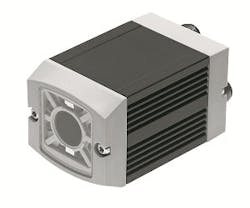The combination of a master controller, sensor interfaces, and various drives often results in very complicated and costly systems that make heavy demands on operators. The compact vision system SBOC-Q, on the other hand, provides an example of how 100 percent quality monitoring can be achieved simply and affordably.
The Festo SBOC-Q utilizes familiar vision tools for parts inspection. These include Blob tools, ROI, and Ray tools. In addition, the vision system supports OCR (optical character recognition) and code scanning for bar codes and data-matrix. These tools are useful in the pharmaceutical industry to ensure 100 percent quality of packaging – blister packs and bottle caps, for example, and checking for proper characters and other necessary information via label codes.
In addition to inspection, this compact vision system is unique in that it has an embedded CoDeSys PLC plus a CANopen master interface. With these features, the possible applications greatly increase. For example, the SBOC-Q can autonomously run an inspection station. The vision system will not only inspect, but also control actuators to reject failing packages, re-orient items such as catheters, or take other physical actions. All necessary information from code reading to OCR can be passed back to a supervisory system via an embedded Ethernet port. Ethernet protocols supported include Ethernet/IP, ModbusTCP, Telnet, OPC, and CoDeSys Ethernet.
Pharmaceutical and Personal Care Applications
The SBOC-Q has been used to measure the diameter of glass ampoules for conformance to specifications. In the same application, the system used backlighting principles to ascertain the presence of printing. For blister checking, the vision system was used to count pills and to assure that there were no empty spots in the pack. If there were empty blisters, the vision system identified the coordinates, made that information
accessible to operators, and then withdraw the pack from the line.
In another application, the SBOC-Q was used for quality inspection of catheters. The system sorted catheters according to the color of the filter, while at the same time, ensuring the completeness of components within each catheter, including needle, filter, case, and cap. In a syringe inspection application, the system was used to identify missing or broken parts such as rubber plunger head, auger flange, thumb rest, and needle hub. A personal care application required the SBOC-Q to check dental floss containers for the presence of the internal roll of dental floss, threads coming out from the correct hole, and threads correctly located on the cutter.
